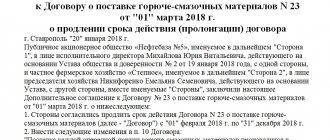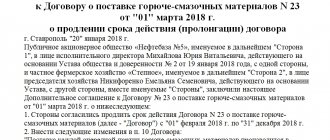- Highlights of the cooperation agreement
- The procedure for concluding a joint activity agreement
- Subject of the contract and confidentiality
- Participants of the cooperation agreement
- Features of the agreement
- Signing procedure
Legal entities have the right to enter into agreements in order to obtain commercial profit. In order to legally formalize intentions for joint actions, it is necessary to draw up agreements on cooperation and joint activities.
Highlights of the cooperation agreement
The standard form of an agreement on cooperation and joint activities must include the following:
- The parties act in joint interests without forming a legal entity (Civil Code of the Russian Federation, Article 1041, paragraph 1);
- The agreement must indicate the numbers of the Unified State Register of Individual Entrepreneurs/Unified State Register of Legal Entities and the passport details of the responsible persons, since the document presupposes an agreement between legal entities (Civil Code of the Russian Federation, Article 1041, paragraph 2);
- It is necessary to indicate the amount of investment or contribution to each of the participants;
- Subject of the agreement. These may be services providing legal, technical assistance, etc. (Article 1042, paragraph 1);
- Drawing up an agreement on cooperation and joint activities involves indicating the boundaries of the use of trade secrets by each party.
IMPORTANT! When filling out the form, in the paragraph on the responsibility of the parties and the resolution of disputes, it is necessary to indicate not only the arbitration court, but also the court of general jurisdiction.
Components of the agreement
There is no established form for this document and is not expected, since its content will directly depend on the specific terms of the agreement and the goals of each party. There may not be two, but three or more. And they all must agree to the conditions that are written in the paper.
There are several elements in the attached sample agreement:
- A cap.
- Subject of the agreement.
- Responsibility of the parties.
- Payment procedure.
- Force majeure circumstances. Other conditions. How the parties resolve possible disputes.
- Duration of the agreement. In the example shown, it is 5 years.
- General provisions. A typical part for all agreements.
- Conclusion.
Introductory part
At the very top, in order, it should be indicated:
- Name of the agreement, its number.
- Date and city of document signing. Typically this data is located on the left and right sides of the sheet.
- Full name of the representative, name of the organization that enters into the agreement.
- On what basis do representatives act (charter, regulations, power of attorney, etc.).
- Who is called “Party 1” in the agreement and who is “Party 2”. This is very important, since the further text of the agreement may involve certain actions or the provision of something by one of the parties.
Subject of the agreement
This part should list all areas of interaction that both parties are willing to enter into. This could be one area, for example, financial. Then the parties agree on loans, credits under certain conditions, etc.
The two parties can describe almost all areas of the subject matter of the agreement. Cooperation in this case takes on the character of a merger of two organizations, but is not it. In addition, the agreement does not imply the conclusion of any subsequent agreement. This part specifically states in what areas organizations can be useful to each other.
Perhaps one of the parties helps the other in one area, and the other in another. Then the subject of the agreement must indicate both of these areas.
Responsibility of the parties
In this clause of the agreement, the parties agree that they will not disclose, for example, each other’s trade secrets, and also stipulates the possibility of providing assistance in certain areas of activity (marketing, obtaining patents, etc.).
Payment procedure
Specific numbers are usually not given at this point. The wording presupposes a conclusion regarding the financial side of the issue in other agreements. If possible, links are provided. But in most cases, organizations limit themselves to a general phrase that profits from transactions are distributed after reaching agreement on this issue.
Professionals advise drawing up a cooperation agreement after each major distribution of profits. This way, the order of calculations will be immediately clear, and there will be no confusion with dates.
Force majeure
It is specified which circumstances constitute force majeure. How the terms of the agreements reached may change. But the main point of this paragraph is the time frame within which one party is obliged to notify the other about what happened (and about the impossibility of fulfilling the obligations specified in the document).
Conclusion
After the cooperation agreement between the organizations has been agreed upon, the necessary amendments have been made to it, and all participants leave their details, signatures, seals, and transcripts on it. It would be useful to indicate the positions of the signing employees (in most cases, heads of organizations), especially if they are mentioned at the beginning of the document.
Subject of the contract and confidentiality
The text of the agreement on cooperation and joint activities must indicate the subject of the agreement. In particular, these may be those activities that the parties decided to carry out jointly. It could be:
- Provision of services;
- Any help;
- Technical support;
- Marketing and more.
When concluding an agreement, you first need to pay close attention to the block with confidential information. It may include certain unique technologies and know-how that are used by one of the parties. The text of the document must list the areas that fall under the category of confidential information and provide for penalties for its disclosure. When concluding a joint activity agreement, you should not forget about possible tax obligations, because As a result of the joint efforts of the parties, they receive profit, which is subject to taxation. In the text of the document, indicate the procedure for calculating and paying taxes.
The concept of a partnership agreement
In practice, lawyers often come across so-called partnership agreements (cooperation agreements, agreements of intent, etc.). However, the Civil Code of the Russian Federation does not include such agreements in a separate chapter.
It is known that when interpreting a contract (for example, to resolve disputes), both parties and courts are guided not by the title of the document, but by its literal content. Consequently, the name of the document establishing the partnership between the parties (for example, a preliminary agreement or protocol of intent, cooperation agreement) is not of fundamental importance. The Civil Code of the Russian Federation, which the parties must follow when concluding any type of agreement, enshrines the concept of only one of these documents - a framework agreement (agreement with open terms - Article 429.1 of the Civil Code of the Russian Federation), which defines the general conditions of the obligatory relationship of the parties, which can be specified and clarified parties by concluding separate agreements, submitting applications from one of the parties or otherwise on the basis of or in pursuance of a framework agreement.
A framework agreement can establish organizational, marketing and financial terms of the relationship, the terms of the agreement (agreements), the conclusion of which is mediated by the framework agreement and involves further specification (clarification, addition) of such conditions through the conclusion of separate agreements, submission of applications, etc. , defining the missing conditions.
More details
For example:
- The framework agreement may specify:
- general conditions for promoting purchased products on the market, bonuses for their distribution;
- penalties have been established for violation of obligations related to the supply of products;
- procedure for resolving disagreements, including an arbitration clause;
- A separate agreement may establish the following conditions:
- on the quantity and quality of the goods supplied;
- delivery date, etc.
The Civil Code of the Russian Federation establishes that if the parties sign a framework agreement, the relations of the parties that are not regulated by separate agreements, including if the parties do not conclude separate agreements, are subject to application of the general conditions contained in the framework agreement, unless otherwise
- not specified in separate agreements or
- does not follow from the essence of the obligation.
Thus, no matter what name the parties assign to an agreement of this kind, the legal relations it defines will correspond to one legal structure - a framework agreement. This design of the contract is advantageous in that the parties can agree in advance on all the conditions of interest, except for the essential ones (type and quantity of goods, a specific list of works or services) - they are subsequently specified in the main agreement, based on their commercial interests.
The terms of the framework agreement are part of a subsequently concluded separate agreement, if such an agreement generally corresponds to the intentions of the parties expressed in the framework agreement, and otherwise is not indicated by the parties or does not follow from the essence of the obligation (Clause 2 of Article 429.1 of the Civil Code of the Russian Federation). The absence of a reference to a framework agreement in a document executing a separate agreement does not in itself indicate the non-application of the terms of the framework agreement.
V.V. Vitryansky: “The difference between a framework agreement is that a full-fledged obligation arises from it; it’s just that some conditions can be clarified by specific agreements. It is understood that the terms of the framework agreement will only be applied subsidiary to specific agreements.”
See also: Deltsova N.V. “On the framework agreement”; A. Karapetov “Framework Agreement: Commentary on the new Article 429.1 of the Civil Code of the Russian Federation”
Legal qualification of a partnership agreement
Based on the fact that the partnership agreement is a framework agreement, it is:
- consensual (considered concluded from the moment the parties reach an agreement on all essential terms);
- gratuitous (does not provide for consideration or any payment in favor of one of the parties);
- bilateral (creates rights and obligations for both sides).
Distinguishing a framework agreement from a preliminary one
A preliminary agreement binds the parties with an obligation to enter into an agreement in the future on the terms specified in it.
The framework agreement, unlike the preliminary agreement, does not contain such an obligation. The parties do not undertake an obligation to enter into an agreement in the future; they have already concluded it, but individual conditions are detailed and clarified later.
For example, at the time of concluding most supply contracts, their parties, as a rule, cannot clearly define the goods that the supplier will supply and the buyer will accept and pay for. Thus, the contract drawn up by the parties, which they call a supply contract, is not concluded, since it does not agree on an essential condition on the subject, as required by Art. 432 of the Civil Code of the Russian Federation, and is actually a framework agreement. The design of the framework agreement in this case makes it possible to formalize the relationship of the parties to the supply agreement, eliminating the risk of recognizing it as not concluded due to the failure to agree on an essential condition on the subject matter.
Distinguishing a framework agreement from an agreement with open terms
An agreement with open terms is, as a rule, a long-term agreement that contains a certain set of agreed upon essential conditions, but stipulates that the parties intend to specify it in the future by concluding additional agreements (see, for example, Article 2.1.14 of the UNIDROIT Principles).
A framework agreement is a special type of agreement with open terms, which is characterized by the fact that it is strictly long-term in nature and designed for repeated use in business practice, and at the same time it defines only the general conditions of the party’s obligations, but postpones the agreement of essential conditions. After concluding a framework agreement, the parties usually begin to periodically sign additional agreements or otherwise fill in essential terms missing from the framework agreement. Entering into contractual relations through the preliminary conclusion of such “empty” partnership agreements with their subsequent specification in terms of essential conditions is very common, as it simplifies negotiations.
Due to the fact that a partnership agreement (cooperation agreement) is aimed at organizing the relations of the parties, establishing their foundations, it allows in the most general form to agree on their subsequent obligations, indicate how their content will be clarified, regulate the order of interaction between the parties, and provide methods of ensuring the fulfillment of their obligations and measures of liability of the party evading the fulfillment of its obligations.
IMPORTANT! The conclusion of a partnership (framework) agreement relieves the parties of the need, when making transactions in its execution, in each specific case to agree on certain conditions on which they have already reached an agreement (Clause 2 of Article 429.1 of the Civil Code of the Russian Federation).
Features of the agreement
An agreement on cooperation and joint activities may also relate to investment activities; in these cases, they are guided by the Federal Law of November 28, 2011 N 335-FZ (as amended on July 21, 2014) “On Investment Partnerships.” This document assumes a number of specific features, such as:
- The parties do not have the right to attract new investors and place advertisements for investment activities (Federal Law of November 28, 2011 N 335-FZ. P. 7);
- The agreement must indicate joint property;
IMPORTANT: The contract must indicate the share and amount of profit received as a result of the agreement. Typically, profit is calculated based on the contribution of each participant. (Civil Code Article 1047, Chapter 55, paragraph 1)
The agreement must indicate the basis for termination of the agreement. The law provides for the following reasons for termination of a document: liquidation of a legal entity due to bankruptcy or for any other reason, expiration of the contract’s statute of limitations.
Agreement of intent
A preliminary agreement, in accordance with the norms of Russian legislation, is an agreement of intent between individuals. Such a transaction is carried out in cases where the partners cannot currently sign the main agreement, but they have such plans. Most often this happens due to the lack of products that are the subject of the agreement, or due to incomplete collection of documents.
The agreement must be drawn up with the inclusion of such important points as:
- Last names and initials of the parties;
- Subject and terms of the agreement;
- Validity;
- Responsibility of subjects for violation of conditions;
- The fact of transfer of money, if it was carried out;
- Date of signing;
- Signature.
As a rule, the sample indicates the amount of a fine or penalty in the event of failure of one of the parties to fulfill the obligations assigned to it.






